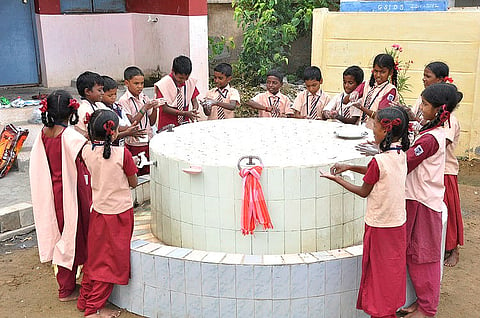

On December 26, 2004, the Panchayat Union Middle School at Keechankuppan in Nagapattinam lost 80 children to the tsunami that struck the south-east coast of India. The aftermath of the disaster saw the school’s strength drop from 425 to less than 100 students after many children dropped out.
Now 13 years later, the new headmaster’s brainwave to convert classes into smart classrooms has not helped bring back the school to its original strength but has made Panchayat Union Middle School one of the most sought-after schools in the district.
Fear and rising dropouts
Following the 2004 disaster, the Tamil Nadu government shifted 200 families from Keechankuppan to nearby towns as part of his rehabilitation measures. “Most of the students began to go to schools in the town as parents were scared to send their children to our school,” says R Balu, Headmaster, Panchayat Union Middle School. He explains that the fear to send children stems from the fact that the school is located near the place where three rivers meet.
Despite efforts by People’s Development Initiatives (PDI), an NGO from Madurai to rebuild the school in 2008, parents were still hesitant to send their wards to study. “Every year, there would be about nine to 12 students admitted in the school. The village administration tried to persuade parents to send their students to the school and also promised their safety but the situation remained the same,” recalls the headmaster.
Then in 2014, the then headmaster retired and R Balu, who was working as a teacher at a government school at Akkaraipettai in Nagapattinam took over. “The Akkaraipettai school was also badly affected due to the tsunami but we were able to bring the students back to school by speaking to the parents individually. We also didn’t give transfer certificates to students who wanted to shift to schools in the town,” he says.
Having seen his work, the village administration approached Balu to join the Panchayat Union Middle School in Keechankuppan. Balu explains, “When I joined, I felt that the children need to have computer education and good English skills. So, we decided to start smart classrooms.”
The school began by conducting medical camps and then individually approached parents to convince them to send their children to the school. “There was a lot of discouragement, people used to say it is unsafe they cannot send their children. But we assured them that if there is another tsunami, alarms have been installed in the school and the students will be taken safely to the top floor, which is much higher than what it was,” said the headmaster.
The school also used the medical camps to spread awareness about their new initiative - smart classrooms. That day saw 28 students seek admission. With the intervention of the district administration, the school managed 134 new students for the 2015-16 academic year.
So what exactly is a smart classroom?
Balu explains, “If we are teaching about the Taj Mahal, we show videos to children. Only 20% of information is taught from the books, the remaining 80% we teach them using internet.”
The headmaster pointed out that CBSE schools charge Rs 8000 for smart classrooms, while the Panchayat Union Middle School at Keechankuppan had the same for minimal cost.
However, the biggest challenge for the school has been funding. “It costs Rs 30 lakhs for three years. Every month, we incur an expenditure of Rs 40,000. We get Rs 24,000 from Sarva Siksha Abhiyan every year and then the villagers and the district administration immensely supports us,” he notes.
With 400 students now enrolled, the children learn spoken English, computer studies apart from their other lessons. As he beams with pride, Balu says the next step is to provide a laptop to each student.
“We are one of the best schools in the district, more parents want to send their children to our school now and we were also awarded Kamarajar Award last year for the best school by the state government,” the headmaster proudly notes.